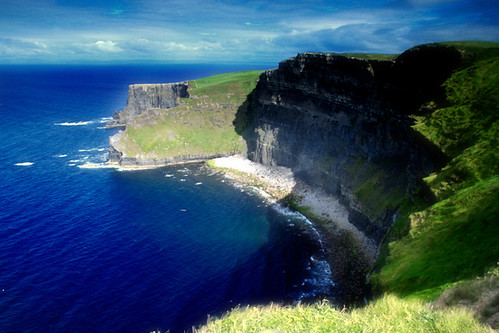A High Energy Solution For Ireland
Posted by Big Gav in energy storage, ireland, wind power
The Times has an article from a Trinity College professor on making Ireland energy self sufficient using wind power and cliff top hydro storage on the west coast - Think tank: A high energy solution.
Ireland has to generate more than 95% of its energy from imported fossil fuels. This arises from our geographical and geological position as a rocky outcrop in the Atlantic Ocean, where fossils fuels could not accumulate to any great extent. But our location is a great asset in terms of power generation. Along with Scotland, Ireland is among the most favourable locations in Europe for wind-power generation.
It is estimated that we use about 24 billion kilowatts (kwh) of energy every year. So if you covered four regions of 12 square kilometres with wind turbines of a cumulative capacity of 12 megawatts (mw) per square kilometre, operating at 40% efficiency, you could provide all of Ireland’s electricity requirements.
This could be an attractive proposition for farmers in the west whose income base is under stress — they could earn additional income by allowing wind turbines to be located on their land. They could still farm the land with the turbines installed. Farmers in the west often think that their main asset is their land. In fact, it’s the wind that blows over it. ...
Whatever energy-generating source we use has to be able to deal with the massive fluctuation in demand during the day. There are peaks between 4pm and 9pm but overnight demand is relatively low.
Ireland has many high cliff areas, so my proposal would be to build vast reservoirs on top of these cliffs and use wind power to pump salt water to them from the ocean. These reservoirs can be thought of as energy-storage areas.
The principle is simple: during times of high-wind activity, turbines would provide the energy to pump the sea water from the ocean, thus filling the reservoirs. In times of peak-energy demand, the reservoirs could be emptied.
The sea water, which is heavier than fresh water, would travel down the connecting pipes, through turbines, thus generating energy.
If water was pumped to a height of 250 metres above sea level and stored in a 2km x 2km, 20 metre-deep reservoir, it could supply all of Ireland’s energy requirements. We can realistically break this down into 10 reservoirs, each measuring 700 by 700 metres and 20 metres deep — we have identified more than 20 possible locations for such reservoirs.
How realistic in purely economic terms is such a project? Well, Ireland requires 2,700 mws of power and in Bath County, Virginia, there is a 2,100 mw pumped/ storage system which cost $1.7 billion (€1.3 billion) to build. We probably do not need to build our reservoirs from scratch because of the unique Irish landscape. This would greatly reduce the construction costs.
The proposal could even be instrumental in helping Ireland out of recession. Consider the impact the Hoover Dam had on the American economy in the 1930s. Some 21,000 people worked on the project and today it is visited by 7m tourists a year. Building reservoirs would give much-needed employment to the construction industry and the resulting structures could add to tourism numbers in the west of Ireland.
Once we have demonstrated that we can achieve energy independence, it should be possible to turn our attention to developing Ireland as a net exporter of energy.






